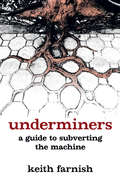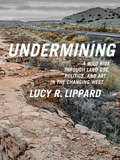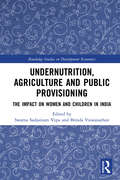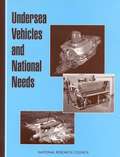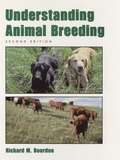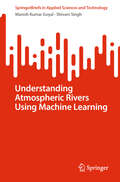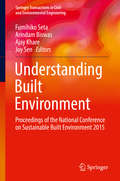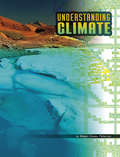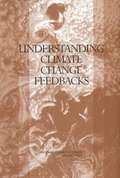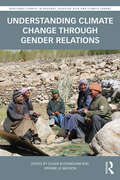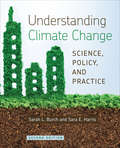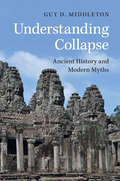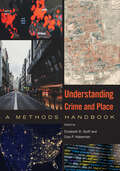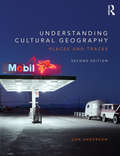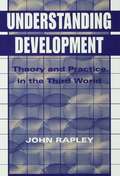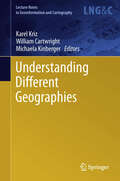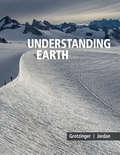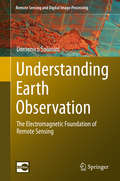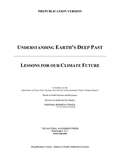- Table View
- List View
Underminers
by Keith FarnishA vibrant, growing movement of radical protest is sweeping North America in opposition to high-stakes capitalism and the appalling environmental desecration that accompanies it. <P><P>At once entertaining, shocking and inspiring, Underminers is the monkey-wrencher's guide to navigating and subverting the industrial machine, showing how symbolic protestors can become real activists; reconnected to one another, and co-creators of a viable future.
Undermining: A Wild Ride Through Land Use, Politics, and Art in the Changing West
by Lucy R. Lippard&“A marvelous slim book [that] weaves . . . ideas, facts, images, and histories into a whole about . . . the ecology of the manmade world.&” —Rebecca Solnit In Undermining, the award-winning author, art historian and social critic Lucy R. Lippard delivers &“another trademark work&” that combines text and full-color images to explore &“the intersection of art, the environment, geography and politics&” (Kirkus Reviews). Working from her own experience of life in a New Mexico village, and inspired by the gravel pits in the surrounding landscape, Lippard addresses a number of fascinating themes—including fracking, mining, land art, adobe buildings, ruins, Indian land rights, the Old West, tourism, photography, and water. In her meditations, she illuminates the relationship between culture, industry, and the land. From threatened Native American sacred sites to the history of uranium mining, she offers a skeptical examination of the &“subterranean economy.&” Featuring more than two hundred gorgeous color images, Undermining offers a provocative new perspective on the relationship between art and place in a rapidly shifting society. &“[Lippard&’s] strength lies in the depth of [her] commitment—her dual loyalty to tradition and modernity and her effort to restore the broken connection between the two.&” —Suzi Gablik, The New York Times Book Review
Undernutrition, Agriculture and Public Provisioning: The Impact on Women and Children in India (Routledge Studies in Development Economics)
by Swarna Sadasivam Vepa Brinda ViswanathanUsing quantitative techniques, this volume provides empirical evidence on the crucial role of public provisioning of food, water, sanitation and health care in reducing undernutrition among women and children in India. The linkages are cogently explored and connected to the sustainable development goals. Key data comes from recent large secondary sources at district, household and individual levels and the econometric methodologies are clearly explained. Taken as a whole, it highlights the effects of public provisioning on malnutrition and identifies the relative importance of agricultural growth in resolving the nutrition problems in rural and semi-urban areas of India. This edited volume will be valuable reading for advanced graduate students, researchers and practitioners in development economics, development studies, and nutrition and public health.
Undersea Vehicles And National Needs
by Committee on Undersea Vehicles National NeedsThe United States faces decisions requiring information about the oceans in vastly expanded scales of time and space and from oceanic sectors not accessible with the suite of tools now used by scientists and engineers. Advances in guidance and control, communications, sensors, and other technologies for undersea vehicles can provide an opportunity to understand the oceans' influence on the energy and chemical balance that sustains humankind and to manage and deliver resources from and beneath the sea. This book assesses the state of undersea vehicle technology and opportunities for vehicle applications in science and industry. It provides guidance about vehicle subsystem development priorities and describes how national research can be focused most effectively.
Understanding Animal Breeding (Second Edition)
by Richard M. BourdonAn experienced animal breeder, Rick Bourdon designed this book to be a modern, technologically up-to-date approach to animal breeding. Understanding Animal Breeding addresses the abstract concepts of animal breeding, presenting the necessary mathematics, but previous experience in genetics and statistics is not assumed. Well organized and readable, the book stresses application, then explains theory for an overall understanding of the material. Coverage explores the latest material on interactions and breeding objectives; performance testing; probabilities and inheritance; the Hardy-Weinberg equilibrium with multiple alleles; realized response to selection; breeding for uniformity; and biotechnology. For practicing animal breeders as well as those interested in breeding and agriculture.
Understanding Atmospheric Rivers Using Machine Learning (SpringerBriefs in Applied Sciences and Technology)
by Manish Kumar Goyal Shivam SinghThis book delves into the characterization, impacts, drivers, and predictability of atmospheric rivers (AR). It begins with the historical background and mechanisms governing AR formation, giving insights into the global and regional perspectives of ARs, observing their varying manifestations across different geographical contexts. The book explores the key characteristics of ARs, from their frequency and duration to intensity, unraveling the intricate relationship between atmospheric rivers and precipitation. The book also focus on the intersection of ARs with large-scale climate oscillations, such as El Niño and La Niña events, the North Atlantic Oscillation (NAO), and the Pacific Decadal Oscillation (PDO). The chapters help understand how these climate phenomena influence AR behavior, offering a nuanced perspective on climate modeling and prediction. The book also covers artificial intelligence (AI) applications, from pattern recognition to prediction modeling and early warning systems. A case study on AR prediction using deep learning models exemplifies the practical applications of AI in this domain. The book culminates by underscoring the interdisciplinary nature of AR research and the synergy between atmospheric science, climatology, and artificial intelligence
Understanding Built Environment
by Fumihiko Seta Arindam Biswas Ajay Khare Joy SenThis book is a comprehensive document visualizing the future of built environment from a multidisciplinary dimension, with special emphasis on the Indian scenario. The multidisciplinary focus would be helpful for the readers to cross-refer and understand others' perspectives. The text also includes case studies substantiating theoretical research. This method of composition helps the book to maintain rational balance among theory, research and its contextual application. The book comprises selected papers from the National Conference on Sustainable Built Environment. The chapters provide varied viewpoints on the core issues of urbanization and planning. This compilation would be of interest to students, researchers, professionals and policy makers.
Understanding Cancer Prevention through Geospatial Science: Putting Cancer in its Place (Global Perspectives on Health Geography)
by Trevor DummerThe worldwide cancer burden will double over the next two decades, with the number of new cancer diagnoses increasing in all regions of the world. However, it is estimated that around 40% of all cancers are preventable through the appropriate application of existing epidemiological and public health knowledge, and with further research this proportion will increase considerably. This edited volume explores the role of place in cancer prevention and how geospatial tools can be used to support this globally important goal. Its chapters detail many aspects of the application of geospatial science to cancer control, including quantifying exposure to environmental carcinogens, access to screening services, the importance of partnership building, and more through a variety of geographically diverse case studies. The book also offers background on geospatial modeling tools and methods for adding spatial analysis to cancer surveillance systems. The book is rooted firmly in the notion that geography significantly influences the accumulation of cancer risks (at the individual and community level) that are modifiable through policy, regulatory, and behavioral changes. The landscape of cancer prevention is vast, encompassing the building blocks of population and public health—i.e., epidemiology and causation—through risk factor modifications, behavior and policy change, to the interface of the cellular with society, including epigenetic modifications and gene/environment interactions, cancer genomics and precision medicine/health. It is clear that geography (space, place, setting, context) is central to all these activities. Geospatial methods and data support risk factor identification, can elucidate the interaction between individual behavioral, demographic, and genetic factors with community level contextual factors, and can be used to prioritize interventions more accurately towards at-risk people and at-risk population groups. Geography is also central to the organization of health services and hence, by definition, is fundamental to the organization of preventative services. More broadly, adopting a geographical approach can help move cancer prevention beyond a narrow medical definition of health, to tackle the upstream and structural determinants of cancer.
Understanding Climate (Discover Meteorology)
by Megan Cooley PetersonSome climates are dry and some are wet. Some are cold and some are warm. But those words can describe weather too. Learn the difference between weather and climate. Find out how landforms and location can influence weather patterns.
Understanding Climate Change
by Sarah Burch Sara HarrisConversations about climate change are filled with challenges involving complex data, deeply held values, and political issues. Understanding Climate Change provides readers with a concise, accessible, and holistic picture of the climate change problem, including both the scientific and human dimensions.Understanding Climate Change examines climate change as both a scientific and a public policy issue. Sarah L. Burch and Sara E. Harris explain the basics of the climate system, climate models and prediction, and human and biophysical impacts, as well as strategies for reducing greenhouse gas emissions, enhancing adaptability, and enabling climate change governance. The authors examine the connections between climate change and other pressing issues, such as human health, poverty, and other environmental problems, and they explore the ways that sustainable responses to climate change can simultaneously address those issues.An effective and integrated introduction to an urgent and controversial issue, Understanding Climate Change contains the tools needed for students, instructors, and decision-makers to become constructive participants in the human response to climate change.
Understanding Climate Change Feedbacks
by Panel On Climate Change FeedbacksDuring the past decade, scientists have learned much about the complex natural processes that influence climate variability and change, and our ability to model climate has increased significantly. We also have begun to better identify those parts of the climate system that are particularly important and not well understood and that therefore limit our ability to project the future evolution of Earth’s climate. One of these critical areas is our understanding of the role of feedbacks in the climate system and their role in determining climate sensitivity. Feedbacks are processes in the climate system that can either amplify or dampen the system’s response to changed forcings. This study looks at what is known and not known about climate change feedbacks and seeks to identify the feedback processes most in need of improved understanding. It identifies key observations needed to monitor and understand climate feedbacks, discusses ways to evaluate progress in understanding climate feedbacks, recommends ways to improve climate modeling and analysis for climate feedbacks research, and identifies priority areas for research.
Understanding Climate Change through Gender Relations (Routledge Studies in Hazards, Disaster Risk and Climate Change)
by Susan Buckingham Virginie Le MassonThis book explains how gender, as a power relationship, influences climate change related strategies, and explores the additional pressures that climate change brings to uneven gender relations. It considers the ways in which men and women experience the impacts of these in different economic contexts. The chapters dismantle gender inequality and injustice through a critical appraisal of vulnerability and relative privilege within genders. Part I addresses conceptual frameworks and international themes concerning climate change and gender, and explores emerging ideas concerning the reification of gender relations in climate change policy. Part II offers a wide range of case studies from the Global North and the Global South to illustrate and explain the limitations to gender-blind climate change strategies. This book will be of interest to students, scholars, practitioners and policymakers interested in climate change, environmental science, geography, politics and gender studies.
Understanding Climate Change through Religious Lifeworlds
by David L. HabermanHow can religion help to understand and contend with the challenges of climate change?Understanding Climate Change through Religious Lifeworld,edited by David Haberman, presents a unique collection of essays that detail how the effects of human-related climate change are actively reshaping religious ideas and practices, even as religious groups and communities endeavor to bring their traditions to bear on mounting climate challenges.People of faith from the low-lying islands of the South Pacific to the glacial regions of the Himalayas are influencing how their communities understand earthly problems and develop meaningful responses to them. This collection focuses on a variety of different aspects of this critical interaction, including the role of religion in ongoing debates about climate change, religious sources of environmental knowledge and how this knowledge informs community responses to climate change, and the ways that climate change is in turn driving religious change.Understanding Climate Change through Religious Lifeworlds offers a transnational view of how religion reconciles the concepts of the global and the local and influences the challenges of climate change.
Understanding Climate Change: Science, Policy, and Practice, Second Edition
by Sarah Burch Sara E. HarrisConversations about climate change are filled with challenges involving complex data, deeply held values, and political issues. Understanding Climate Change examines climate change as both a scientific and a public policy issue. Sarah L. Burch and Sara E. Harris explain the basics of the climate system, climate models and prediction, and human and biophysical impacts, as well as strategies for climate change adaptation and mitigation. The second edition has been fully updated throughout, including coverage of new advances in climate modelling and of the shifting landscape of renewable energy production and distribution. A brand new chapter discusses global governance, including the United Nations Framework Convention on Climate Change and the Paris Agreement, as well as mitigation efforts at the national and subnational levels. This new chapter makes the book even more relevant to climate change courses housed in social sciences departments such as political science and geography. An effective and integrated introduction to an urgent and controversial issue, this book is well-suited to adoption in a variety of introductory climate change courses found in a number of science and social science departments. Its ultimate goal is to equip readers with the tools needed to become constructive participants in the human response to climate change.
Understanding Collapse: Ancient History and Modern Myths
by Guy D. MiddletonUnderstanding Collapse explores the collapse of ancient civilisations, such as the Roman Empire, the Maya, and Easter Island. In this lively survey, Guy D. Middleton critically examines our ideas about collapse - how we explain it and how we have constructed potentially misleading myths around collapses - showing how and why collapse of societies was a much more complex phenomenon than is often admitted. Rather than positing a single explanatory model of collapse - economic, social, or environmental - Middleton gives full consideration to the overlooked resilience in communities of ancient peoples and the choices that they made. He offers a fresh interpretation of collapse that will be accessible to both students and scholars. The book is an engaging, introductory-level survey of collapse in the archaeology/history literature, which will be ideal for use in courses on the collapse of civilizations, sustainability, and climate change. It includes up-to-date case studies of famous and less well-known examples of collapses, and is illustrated with 25 black and white illustrations, 3 line drawings, 16 tables and 18 maps.
Understanding Crime and Place: A Methods Handbook
by Elizabeth R. Groff and Cory P. HabermanPlace has become both a major field of criminological study as well as an important area for policy development. Capturing state of the art crime and place research methods and analysis, Understanding Crime and Place is a comprehensive Handbook focused on the specific skills researchers need. The editors and contributors are scholars who have been fundamental in introducing or developing a particular method for crime and place research. Understanding Crime and Place is organized around the scientific process, introducing major crime and place theories and concepts, discussions of data and data collection, core spatial data concepts, as well as statistical and computational techniques for analyzing spatial data and place-based evaluation. The lessons in the book are supplemented by additional instructions, examples, problems, and datasets available for download. Conducting place-based research is an emerging field that requires a wide range of cutting-edge methods and analysis techniques that are only beginning to be widely taught in criminology. Understanding Crime and Place bridges that gap, formalizes the discipline, and promotes an even greater use of place-based research. Contributors: Martin A. Andresen, Matthew P J Ashby, Eric Beauregard, Wim Bernasco, Daniel Birks, Hervé Borrion, Kate Bowers, Anthony A. Braga, Tom Brenneman, David Buil-Gil, Meagan Cahill, Stefano Caneppele, Julien Chopin, Jeffrey E. Clutter, Toby Davies, Hashem Dehghanniri, Jillian Shafer Desmond, Beidi Dong, John E. Eck, Miriam Esteve, Timothy C. Hart, Georgia Hassall, David N. Hatten, Julie Hibdon, James Hunter, Shane D. Johnson, Samuel Langton, YongJei Lee, Ned Levine, Brian Lockwood, Dominique Lord, Nick Malleson, Dennis Mares, David Mazeika, Lorraine Mazerolle, Asier Moneva, Andrew Newton, Bradley J. O’Guinn, Ajima Olaghere, Graham C. Ousey, Ken Pease, Eric L. Piza, Jerry Ratcliffe, Caterina G. Roman, Stijn Ruiter, Reka Solymosi, Evan T. Sorg, Wouter Steenbeek, Hannah Steinman, Ralph B. Taylor, Marie Skubak Tillyer, Lisa Tompson, Brandon Turchan, David Weisburd, Brandon C. Welsh, Clair White, Douglas J. Wiebe, Pamela Wilcox, David B. Wilson, Alese Wooditch, Kathryn Wuschke, Sue-Ming Yang, and the editors.
Understanding Cultural Geography: Places and Traces
by Jon AndersonThis book outlines how the theoretical ideas, empirical foci, and methodological techniques of cultural geography make sense of the ‘culture wars’ that define our time. It is on the battleground of culture that our opportunities, rights, and futures are determined and Understanding Cultural Geography showcases how this discipline can be used to understand these battles and how we can engage in them. Through doing so, the book not only introduces the reader to the rich and complex history of cultural geography, but also the key terms on which the discipline is built. From these insights, the text approaches place as an ‘ongoing composition of traces’, highlighting the dynamic and ever-changing nature of the world around us, and what our role can be in transforming it for the better. The third edition has been fully revised and updated to incorporate recent literature and reflect the changing cultural context of its time. Retaining its exciting and innovative structure, the third edition will expand its focus into new areas, including updated chapters on ethnicity and race, and new chapters on gender and the body. This new edition captures not only recent changes in the cultural world, but also the discipline itself, offering the most up-to-date text to understand and engage with the cultural battlegrounds which constitute our lives. Understanding Cultural Geography is the ideal text for students being introduced to the discipline through either undergraduate or postgraduate degree courses. The third edition is an important update to a highly successful text that incorporates a vast foundation of knowledge; it is an invaluable book for lecturers and students.
Understanding Cultural Geography: Places and traces
by Jon AndersonUnderstanding Cultural Geography: Places and Traces offers a comprehensive introduction to perhaps the most exciting and challenging area of human geography. By focusing on the notion of 'place' as a key means through which culture and identity is grounded, the book showcases the broad range of theories, methods and practices used within the discipline. This book not only introduces the reader to the rich and complex history of cultural geography, but also the key terms on which the discipline is built. From these insights, the book approaches place as an 'ongoing composition of traces', highlighting the dynamic and ever-changing nature of the world around us. The second edition has been fully revised and updated to incorporate recent literature and up-to-date case studies. It also adopts a new seven section structure, and benefits from the addition of two new chapters: Place and Mobility, and Place and Language. Through its broad coverage of issues such as age, race, scale, nature, capitalism, and the body, the book provides valuable perspectives into the cultural relationships between people and place. Anderson gives critical insights into these important issues, helping us to understand and engage with the various places that make up our lives. Understanding Cultural Geography is an ideal text for students being introduced to the discipline through either undergraduate or postgraduate degree courses. The book outlines how the theoretical ideas, empirical foci and methodological techniques of cultural geography illuminate and make sense of the places we inhabit and contribute to. This is a timely update on a highly successful text that incorporates a vast foundation of knowledge; an invaluable book for lecturers and students.
Understanding Development: Theory And Practice In The Third World
by John RapleyFirst published in 1997. Routledge is an imprint of Taylor & Francis, an informa company.
Understanding Different Geographies
by Karel Kriz Michaela Kinberger William CartwrightThis book collects revised versions of papers first delivered at the "Understanding Different Geographies Symposium" held in Puchberg am Schneeberg, Austria in 2011. The Symposium focussed on "Communicating Meaning with [Geo]Graphic Artefacts". The general topics of the chapters cover: - Exploring geographic knowledge - Maps in exhibition spaces - Information and exhibition design with (geo)graphic artefacts - Extracting meaning from visualisations of different geographies - Deconstructing maps of information - and other spaces
Understanding Downhole Microseismic Data Analysis: With Applications in Hydraulic Fracture Monitoring
by Jubran AkramThis book is designed as an excellent resource text for students and professionals, providing an in-depth overview of the theory and applications of downhole microseismic monitoring of hydraulic fracturing. The readers will benefit greatly from the detailed explanation on the processes and workflows involved in the acquisition design modeling, processing and interpretation of microseismic data.
Understanding Earth
by John Grotzinger Thomas JordanGeology is everywhere in our daily lives. We are surrounded by materials and resources extracted from the Earth, our climate is changing at alarming rates, and hazards due to Earth’s processes are leading to major catastrophes. We will be reliant upon a population of informed citizens to make and vote for policies that protect our Earth, and change that will keep our planet habitable. Therefore, understanding our Earth has never been more important. Understanding Earth leads the way by fully integrating the study of climate science into the core intro geology curriculum. Through strategic placement of the climate science chapters at the beginning of the geomorphology content, we offer a text that places our changing climate as a key force shaping the rest of our discussion on Earth’s surficial processes.
Understanding Earth Observation
by Domenico SoliminiThis volume addresses the physical foundation of remote sensing. The basic grounds are presented in close association with the kinds of environmental targets to monitor and with the observing techniques. The book aims at plugging the quite large gap between the thorough and quantitative description of electromagnetic waves interacting with the Earth's environment and the user applications of Earth observation. It is intended for scientifically literate students and professionals who plan to gain a first understanding of remote sensing data and of their information content.
Understanding Earth's Deep Past
by The National Academy of SciencesA committee appointed to the task assesses both the demonstrated and the underdeveloped potential of the deep-time geological record to inform people about the dynamics of the global climate system in response to the spectrum of forcings and conditions under which it has operated. Much of the effort went to describing past climate changes and their impacts on local ecosystems. There is no index. Annotation ©2011 Book News, Inc. , Portland, OR (booknews. com)
Understanding Ecological Programming: Merging Theory, Research, and Practice
by Susan Scherffiu Jakes Craig BrookinsIncrease the effectiveness of prevention programs by altering community and social settings! Understanding Ecological Programming: Merging Theory, Research, and Practice contains vital information to help you become a better community-based program designer using ecological programming. Focused on the basic concept of the ecological progra
